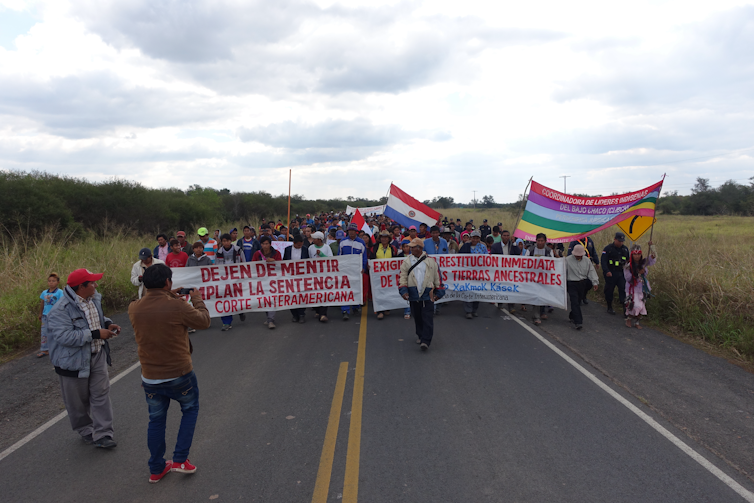We Now Have a Universal Right to a Healthy and Sustainable Environment

Climate change is already affecting much of the world’s population, with startlingly from the to . Air pollution from , , and . are dying in that may force changes in crop production and food availability.
What do these have in common? They represent the new frontier in human rights.
The voted overwhelmingly on July 28, 2022, to declare the ability to live in “” a . It also called on countries, companies, and international organizations to scale up efforts to turn that into reality.
The declaration is not legally binding—countries can vote to support a declaration of rights those rights in practice. The is also vague, leaving to interpretation just what a clean, healthy, and sustainable environment is.
Still, it’s more than moral posturing. Resolutions like this have a history of laying the foundation for effective treaties and national laws.
I am a who focuses on , and much of investigates relationships between development-driven environmental change, natural resource use, and human rights. Here are some examples of how similar resolutions have opened doors to stronger actions.
How the Concept of Human Rights Expanded
In 1948, in the aftermath of World War II, the newly formed United Nations adopted the in response to the atrocities of the Holocaust. The declaration wasn’t legally binding, but it established a baseline of rights intended to ensure the conditions for basic human dignity.
That the right to life, religious expression, freedom from slavery, and a standard of living adequate for health and well-being.
Since then, the scope of human rights has been expanded, including several agreements that are legally binding on the countries that ratified them. The U.N. conventions (1984) and (1965) and on the rights (1989) and (2006) are just a few examples. Today, the also includes binding agreements on , . Eleanor Roosevelt and others read from the articles of the Universal Declaration of Human Rights.
Today’s Triple Planetary Crisis
The world has changed dramatically since the Universal Declaration of Human Rights was written, perhaps most notably with regard to the scale of environmental crises people worldwide face.
Some that the “” of , , and unmitigated pollution now threaten to surpass the necessary to live safely on Earth.
These threats the right to life, dignity, and health, as can air pollution, contaminated water, and pollution from plastics and chemicals. That is why for the U.N. to declare a right to a clean, healthy, and sustainable environment.
The U.N. has been discussing the environment as a global concern for over , and several international treaties over that time have addressed specific environmental concerns, including binding agreements on and . The 2015 to limit global warming is a direct and legally binding outcome of the long struggles that follow initial declarations.
The resolution on the right to a clean, healthy, and sustainable environment was approved without dissent, though : Belarus, Cambodia, China, Ethiopia, Iran, Kyrgyzstan, Russia, and Syria.
The Human Right to Water
Voluntary human rights declarations can also in changing state policy and providing people with to demand better conditions.
The is one of the strongest examples of how U.N. resolutions have been used to shape state policy. The resolution, adopted in 2010, recognizes that access to adequate quantities of clean drinking water and sanitation are necessary to realize all other rights. Diarrheal disease, largely from unsafe drinking water, under age 5 every year.
Human rights advocates used the resolution to help pressure the Mexican government to and adopt a human right to water in 2012. While the concept still , the idea of a right to water is also credited with in marginalized communities in , , and .
The Rights of Indigenous Peoples
The 2007 U.N. is another example. the specific histories of that many Indigenous peoples around the world have endured, and .
The resolution outlines rights for Indigenous peoples but stops short of recognizing their sovereignty, something many critique as . Within these limits, however, several countries have . In 2009, integrated it .

The Declaration on the Rights of Indigenous Peoples discusses a right to about development and industrial projects that would affect Indigenous people. That has been a powerful tool for Indigenous peoples to through the legal system.
In , , and , Indigenous peoples have used the resolution to help win important legal victories before human rights courts with rulings that have led to land restitution and other legal gains.
Tools for Change
U.N. declarations of human rights are aspirational norms that seek to ensure a more just and equitable world. Even though declarations like this one are not legally binding, they can be vital tools people can and private companies to protect or improve human well-being.
Change can take time, but I believe this latest declaration of human rights will support climate and environmental justice across the world.
This article was originally published by . It has been published here with permission.
|
Joel E. Correia
is a human-environment geographer whose research and teaching focus on geographies of justice by investigating intersections of human rights, development, and environmental change with attention to Indigenous politics in Latin America. Much of that work examines dynamics of large-scale infrastructure development, expanding extractive frontiers, deforestation, Indigenous rights, territorialities, and social movements.
|




